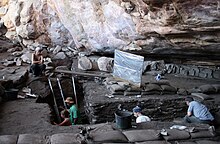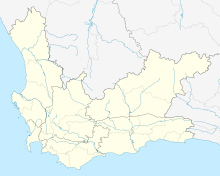| Diepkloof Rock Shelter | |
|---|---|
 General view of Diepkloof Rock Shelter | |
| Location | Verlorenvlei, Western Cape |
| Coordinates | 32°23′12″S 18°27′10″E / 32.38667°S 18.45278°E |
| Geology | Quartzitic Sandstone |
| Official name | Diepkloof Rock Shelter |
| Part of | The Emergence of Modern Human Behaviour: The Pleistocene Occupation Sites of South Africa |
| Criteria | Cultural: iii, iv, v |
| Inscription | 2024 (46th Session) |


Diepkloof Rock Shelter is a rock shelter in Western Cape, South Africa in which has been found some of the earliest evidence of the human use of symbols, in the form of patterns engraved upon ostrich eggshell water containers. These date around 60,000 years ago.[1][2]
The symbolic patterns consist of lines crossed at right angles or oblique angles by hatching. It has been suggested that "by the repetition of this motif, early humans were trying to communicate something. Perhaps they were trying to express the identity of the individual or the group."[3]
In 2024, the Diepkloof Rock Shelter became a part of the World Heritage Site of Pleistocene Occupation Sites of South Africa.[4]
- ^ Texier, PJ; Porraz, G; Parkington, J; Rigaud, JP; Poggenpoel, C; Miller, C; Tribolo, C; Cartwright, C; Coudenneau, A; Klein, R; Steele, T; Verna, C (2010). "A Howiesons Poort tradition of engraving ostrich eggshell containers dated to 60,000 years ago at Diepkloof Rock Shelter, South Africa". Proceedings of the National Academy of Sciences. 107 (14): 6180–6185. doi:10.1073/pnas.0913047107. PMC 2851956. PMID 20194764.
- ^ Cite error: The named reference
Tribolowas invoked but never defined (see the help page). - ^ Amos, J. (2010). Etched ostrich eggs illustrate human sophistication. BBC News
- ^ "The Emergence of Modern Human Behaviour: The Pleistocene Occupation Sites of South Africa". UNESCO World Heritage Centre. Retrieved 1 August 2024.
